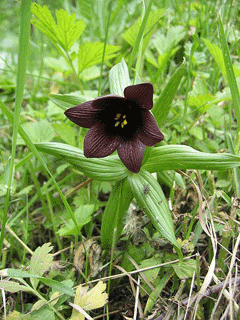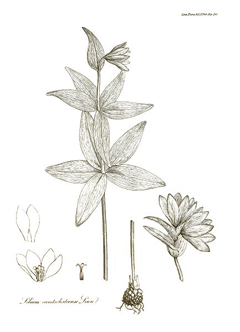 |
|
http://commons.wikimedia.org/wiki/User:Ixitixel |
 |
| Illustration of Lilium camtschatcense and a page from Volume X of Transactions of the Linnean Society of London, published in 1811. |
Translate this page:
Summary
Physical Characteristics

 Fritillaria camschatcensis is a BULB growing to 0.5 m (1ft 8in) by 0.1 m (0ft 4in).
Fritillaria camschatcensis is a BULB growing to 0.5 m (1ft 8in) by 0.1 m (0ft 4in).
See above for USDA hardiness. It is hardy to UK zone 4. It is in flower in May. The species is hermaphrodite (has both male and female organs) and is pollinated by Flies.
Suitable for: light (sandy) and medium (loamy) soils and prefers well-drained soil. Suitable pH: mildly acid, neutral and basic (mildly alkaline) soils and can grow in saline soils.
It can grow in semi-shade (light woodland) or no shade. It prefers moist soil.
UK Hardiness Map
US Hardiness Map
Synonyms
Lilium camschatcensis.
Plant Habitats
Woodland Garden Sunny Edge; Dappled Shade;
Edible Uses
Edible Parts: Root Seedpod
Edible Uses:
Bulb - raw, cooked or dried for later use[2, 46, 105, 183]. A staple food in areas where it grows wild[177], when cooked it tastes like baked chestnuts[74]. One report says that the bulbs have a slightly bitter taste, even after cooking[256]. The best-tasting bulbs are said to come from coastal areas where the plants are occasionally covered with salt water[254]. A pudding is made by mixing the bulbs with the fruit of Empetrum nigrum[183]. The bulb is also dried and ground into a powder, then used as a flour or starch for making breads and soups[183]. The bulb is best if harvested in the autumn[172], it resembles a cluster of cooked rice grains[207]. The green seedpods can be eaten raw or cooked. They are somewhat bitter[172].
References More on Edible Uses
Medicinal Uses
Plants For A Future can not take any responsibility for any adverse effects from the use of plants. Always seek advice from a professional before using a plant medicinally.
None known
References More on Medicinal Uses
The Bookshop: Edible Plant Books
Our Latest books on Perennial Plants For Food Forests and Permaculture Gardens in paperback or digital formats.

Edible Tropical Plants
Food Forest Plants for Hotter Conditions: 250+ Plants For Tropical Food Forests & Permaculture Gardens.
More

Edible Temperate Plants
Plants for Your Food Forest: 500 Plants for Temperate Food Forests & Permaculture Gardens.
More

More Books
PFAF have eight books available in paperback and digital formats. Browse the shop for more information.
Shop Now
Other Uses
References More on Other Uses
Cultivation details
A woodland plant, preferring a moraine or rock garden[1]. Easily grown in a light moist but well-drained sandy woodland soil[42, 163, 200]. Prefers a moist peaty soil and partial shade and must not be allowed to become dry[90]. Another report says that it prefers a sunny position[42] whilst yet another says that it succeeds in full sun or light shade in a rich soil[200]. The plants often grow close to the sea and survive periodic inundation with salt water[256]. The dormant bulb is very hardy and has withstood soil temperatures down to -20°c, though the embryonic flower shoot will be damaged at temperatures around -15°c[214]. A very ornamental plant[1], it is very variable in size and flower colour[90]. The flowers are sweetly scented[245]. Plants flower within 3 - 5 years from seed[164]. The plant is heat tolerant in zones 8 through 2. (Plant Hardiness Zones show how well plants withstand cold winter temperatures.
Plant Heat Zones show when plants would start suffering from the heat.
The Plant Heat Zone map is based on the number of "heat days" experienced in a given area where the temperature climbs to over 86 degrees F (30°C).
At this temperature, many plants begin to suffer physiological damage. Heat Zones range from 1 (no heat days) to 12 (210 or more heat days).
For example Heat Zone. 11-1 indicates that the plant is heat tolerant in zones 11 through 1.) For polyculture design as well as the above-ground architecture (form - tree, shrub etc. and size shown above) information on the habit and root pattern is also useful and given here if available. The plant growth habit is a clumper with limited spread [1-2]. The root pattern is rhizomatous with underground stems sending roots and shoots along their length [1-2].
References Carbon Farming Information and Carbon Sequestration Information
Temperature Converter
Type a value in the Celsius field to convert the value to Fahrenheit:
Fahrenheit:
The PFAF Bookshop
Plants For A Future have a number of books available in paperback and digital form. Book titles include Edible Plants, Edible Perennials, Edible Trees,Edible Shrubs, Woodland Gardening, and Temperate Food Forest Plants. Our new book is Food Forest Plants For Hotter Conditions (Tropical and Sub-Tropical).
Shop Now
Plant Propagation
Seed - best sown as soon as ripe in a cold frame, it should germinate in the spring[1]. Protect from frost[134]. Stored seed should be sown as soon as possible and can take a year or more to germinate[134]. Sow the seed quite thinly to avoid the need to prick out the seedlings. Once they have germinated, give them an occasional liquid feed to ensure that they do not suffer mineral deficiency. Once they die down at the end of their second growing season, divide up the small bulbs, planting 2 - 3 to an 8cm deep pot. Grow them on for at least another year in light shade in the greenhouse before planting them out whilst dormant. Division of offsets in August[1]. The larger bulbs can be planted out direct into their permanent positions, but it is best to pot up the smaller bulbs and grow them on in a cold frame for a year before planting them out in the autumn. Bulb scales[163].
Other Names
If available other names are mentioned here
Native Range
TEMPERATE ASIA: Hokkaidô, Honshu, Japan, Kamcatskij kraj, Kurile Islands, Primorye, Sakhalin,Russian Federation. NORTHERN AMERICA: Canada, Yukon (southwest), British Columbia, United States, Alaska (south), Oregon (northwest), Washington (northwest),
Weed Potential
Right plant wrong place. We are currently updating this section.
Please note that a plant may be invasive in one area but may not in your area so it's worth checking.
Conservation Status
IUCN Red List of Threatened Plants Status :

Growth: S = slow M = medium F = fast. Soil: L = light (sandy) M = medium H = heavy (clay). pH: A = acid N = neutral B = basic (alkaline). Shade: F = full shade S = semi-shade N = no shade. Moisture: D = dry M = Moist We = wet Wa = water.
Now available:
Food Forest Plants for Mediterranean Conditions
350+ Perennial Plants For Mediterranean and Drier Food Forests and Permaculture Gardens.
[Paperback and eBook]
This is the third in Plants For A Future's series of plant guides for food forests tailored to
specific climate zones. Following volumes on temperate and tropical ecosystems, this book focuses
on species suited to Mediterranean conditions—regions with hot, dry summers and cool, wet winters,
often facing the added challenge of climate change.
Read More
Expert comment
Author
(L.)Ker-Gawl.
Botanical References
60200270
Links / References
For a list of references used on this page please go here
Readers comment
© 2010, Plants For A Future. Plants For A Future is a charitable company limited by guarantee, registered in England and Wales. Charity No. 1057719, Company No. 3204567.